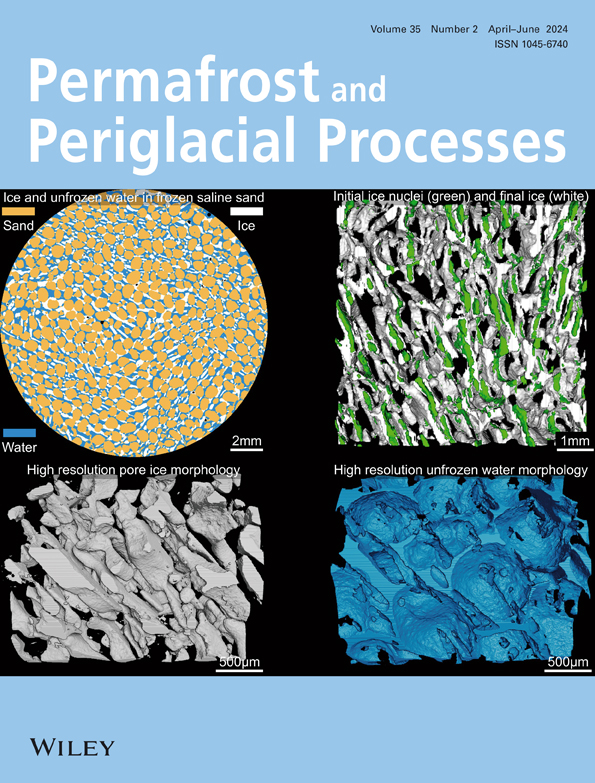Geographic object‐based image analysis (GEOBIA) of the distribution and characteristics of aeolian sand dunes in Arctic Sweden
IF 3.3
3区 地球科学
Q2 GEOGRAPHY, PHYSICAL
引用次数: 1
Abstract
Current climate change in the Arctic is unprecedented in the instrumental record, with profound consequences for the environment and landscape. In Arctic Sweden, aeolian sand dunes have been impacted by climatic changes since their initial formation after the retreat of the last glacial ice sheet. Dune type, location and orientation can therefore be used to explore past wind patterns and landscape destabilisation in this sensitive area. However, knowledge of the full spatial extent and characteristics of these dunes is limited by their inaccessibility and dense vegetation cover. Geographic object‐based image analysis (GEOBIA) permits the semi‐automatic creation of reproducible parameter‐based objects and can be an appropriate means to systematically and spatially map these dunes remotely. Here, a digital elevation model (DEM) and its derivatives, such as slope and curvature, were segmented in a GEOBIA context, enabling the identification and mapping of aeolian sand dunes in Arctic Sweden. Analysis of the GEOBIA‐derived and expert‐accepted polygons affirms the prevalence of parabolic dune type and reveals the coexistence of simple dunes with large coalesced systems. Furthermore, mapped dune orientations and relationships to other geomorphological features were used to explore past wind directions and to identify sediment sources as well as the reasons for sand availability. The results indicate that most dune systems in Arctic Sweden were initially supplied by glaciofluvial and fluvial disturbances of sandy esker systems. Topographic control of wind direction is the dominant influence on dune orientation. Further, our approach shows that analysing the GEOBIA‐derived dune objects in their geomorphological context paves the way for successfully investigating aeolian sand dune location, type and orientation in Arctic Sweden, thereby facilitating the understanding of post‐glacial landscape (in)stability and evolution in the area.瑞典北极地区风成沙丘分布和特征的基于地理对象的图像分析(GEOBIA)
北极当前的气候变化是前所未有的,对环境和景观产生了深远影响。在瑞典北极地区,风成沙丘自上次冰川冰盖消退后最初形成以来,一直受到气候变化的影响。因此,沙丘的类型、位置和方向可用于探索该敏感地区过去的风模式和景观不稳定。然而,由于难以接近和植被茂密,对这些沙丘的完整空间范围和特征的了解有限。基于地理对象的图像分析(GEOBIA)允许半自动创建可复制的基于参数的对象,并且可以成为远程系统和空间绘制这些沙丘地图的适当手段。在这里,数字高程模型(DEM)及其衍生物,如坡度和曲率,在GEOBIA背景下进行了分割,从而能够识别和绘制瑞典北极地区的风成沙丘。对GEOBIA衍生和专家认可的多边形的分析证实了抛物线型沙丘的普遍性,并揭示了简单沙丘与大型联合系统的共存。此外,绘制的沙丘方向和与其他地貌特征的关系被用来探索过去的风向,并确定沉积物来源以及沙子可用性的原因。研究结果表明,瑞典北极地区的大多数沙丘系统最初是由沙质esker系统的冰川-河流和河流扰动提供的。风向的地形控制是影响沙丘定向的主要因素。此外,我们的方法表明,在地貌背景下分析GEOBIA衍生的沙丘物体,为成功调查瑞典北极地区的风成沙丘位置、类型和方向铺平了道路,从而有助于了解该地区冰川后景观的稳定性和演变。
本文章由计算机程序翻译,如有差异,请以英文原文为准。
求助全文
约1分钟内获得全文
求助全文
来源期刊
CiteScore
9.70
自引率
8.00%
发文量
43
审稿时长
>12 weeks
期刊介绍:
Permafrost and Periglacial Processes is an international journal dedicated to the rapid publication of scientific and technical papers concerned with earth surface cryogenic processes, landforms and sediments present in a variety of (Sub) Arctic, Antarctic and High Mountain environments. It provides an efficient vehicle of communication amongst those with an interest in the cold, non-glacial geosciences. The focus is on (1) original research based on geomorphological, hydrological, sedimentological, geotechnical and engineering aspects of these areas and (2) original research carried out upon relict features where the objective has been to reconstruct the nature of the processes and/or palaeoenvironments which gave rise to these features, as opposed to purely stratigraphical considerations. The journal also publishes short communications, reviews, discussions and book reviews. The high scientific standard, interdisciplinary character and worldwide representation of PPP are maintained by regional editorial support and a rigorous refereeing system.

 求助内容:
求助内容: 应助结果提醒方式:
应助结果提醒方式:


